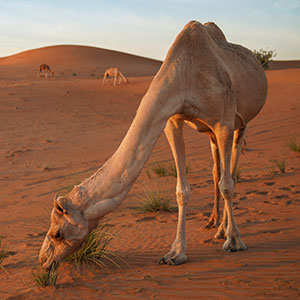Commemorating World Camel Day every year on 22 June, the Abu Dhabi Agriculture and Food Safety Authority (ADAFSA) intensifies efforts to promote camel domestication and strengthen its status as an authentic cultural heritage as well as its economic position in the food security system. This is achieved by providing quality veterinary services, raising awareness on the importance of camel health, breeding and production, and participating in international efforts to ensure the growth and sustainability of the strategic sector. The camel population in the Emirate of Abu Dhabi is 476,082, with 99,071 in Abu Dhabi (83,879 females and 15,192 males), 254,034 in Al Ain (215,968 females and 38,066 males) and 122,977 in the Al Dhafra region (104,987 females and 17,990 males).
This year's celebrations coincide with the International Year of the Camel, designated by the United Nations in 2024. The International Year of the Camel aims to highlight the economic and cultural value of camels in over 90 countries. It also highlights the vital role that camels play in enhancing food security by providing milk, meat and fiber, as well as the fact that some communities use camels as a means of transporting goods and people, contributing to the achievement of the Sustainable Development Goals related to eradicating hunger, eliminating poverty, empowering women, and protecting and preserving ecosystems.
ADAFSA provides comprehensive care for camels, including preventive, therapeutic and productive veterinary services, provision of vaccines and medicines, as well as disease and pest control. Last year, 185,797 veterinary services were provided to 130,700 camels, covering various types of treatments, examinations and follow-ups. In addition, the Authority provided camel spraying services to eliminate external parasites to 237,487 camels in the past year to 2023.
ADAFSA has supported the Al Dhafra Camel Mazaina (Beauty Pageant) Festival since 2009, providing therapeutic and preventive veterinary services and carrying out clinical tests for the participating camels. The same goes for the camel races, where the authority provides veterinary services to the participating camels. ADAFSA's annual involvement ensures the health and safety of the camels and promotes fair competition among participants.
The authorities also conduct regular breeding checks, ear tagging, register them in the Animal Identification and Registration System, regularly spray for external parasites and issue veterinary and health certificates for camels intended for export to various countries.
As part of raising awareness about the importance of caring for camels, the authority has produced various brochures with guidelines on best practices for keeping and caring for camels. ADAFSA has also published the World Organisation for Animal Health (WOAH) certified Atlas of Camel Pathology, a full-colour encyclopedia covering all diseases prevalent in camels requiring surgical intervention in the UAE and the Arabian Peninsula. The authority has also organised a number of educational talks on the benefits of camel milk and workshops to educate camel breeders about camel diseases, how to prevent and treat them, and biosecurity requirements to build immunity against diseases in camels.
Internationally, ADAFSA is involved in camel health efforts, including collaborating with the Food and Agriculture Organization of the United Nations (FAO) on camel coronaviruses and collaborating with universities in the UAE to collect samples. The ADAFSA Camel Disease Collaborating Centre, accredited by WOAH, continues to conduct pioneering research, develop diagnostic techniques for epidemic animal diseases, including camel diseases, support outbreak response activities, capacity building and disseminate scientific knowledge on camel diseases.
Over the past two years, the Center has provided laboratory analysis services for over 100,000 samples collected from camels for a range of diseases, totalling over 500,000 analytical results, and developed over 150 advanced laboratory assays that enable precise identification of pathogens, supporting strategic planning for disease prevention, control and food security.
The center has also established the first biobank of reference material for storing camel biological isolates and specialised tissue culture cells, which will improve disease control, vaccine development, diagnostic kits, laboratory analytical methods, scientific research and training.
In terms of scientific publishing, experts and specialists of the Center have published more than 30 scientific papers on animal and human diseases (from the One Health perspective) in reputed scientific journals. In addition, several activities are carried out within the Middle East Camel Network (CAMENET), which includes the Gulf Cooperation Council (GCC) countries, Jordan and Yemen. The Network aims to contribute to the development, unification and validation of diagnostic methods for major camel diseases according to internationally accepted standards and procedures, to strengthen scientific and technological capacities in the field of epidemiology and diagnosis of camel diseases in the region, and to characterize and define camel ecotypes based on morphological characteristics.
In addition, the Network aims to disseminate knowledge on camel disease control and best practices in camel production to Member States and the international scientific community, promote research and investigations on camel husbandry and production practices and their socio-economic importance, identify risks and other threats to animals, humans and the environment, and facilitate cooperation between national, regional and international organizations and reference laboratories affiliated to FAO, WOAH and collaborating centres for capacity building, exchange of experiences and collaboration.
The reference centre has added complete or partial genetic sequences of various pathogens affecting camels to the global gene bank, strengthening the country's position in camel disease research.Furthermore, the availability of modern diagnostic tools has significantly improved the accuracy of diagnosis, which will also be of great help in unraveling the mysteries of many camel diseases.
Knowing the genetic sequences of camel pathogens, especially viruses, helps in controlling them by understanding their epidemiology, pathogenesis and genetic maps. It also helps in developing new diagnostic methods and studying the possible combinations and mutations of viruses, resulting in viruses with different virulence, thus improving the efficiency of diagnosis of different camel diseases.



